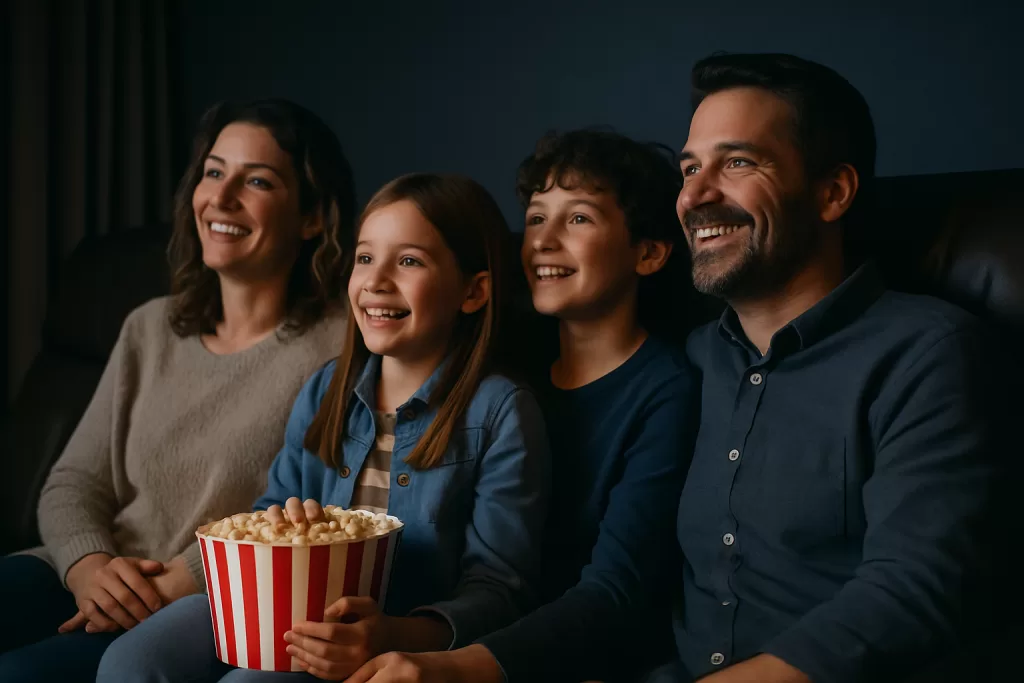
If you’re planning a home theater in Kansas City, one of the first questions you’ll ask is, “How much will it cost?” The answer depends on your vision — whether it’s a cozy movie room starting around $25,000 or a reference-level cinema over $150,000. In this guide, we’ll break down the key factors that influence home theater pricing so you can make confident decisions and create a space that fits your home, lifestyle, and budget.
Since the day we were born, we’ve been experiencing the sights and sounds of the world around us. A home theater’s job is to recreate that reality — or even enhance it — in a way that fits your space, your preferences, and your budget. But what exactly drives the cost of a professionally designed home theater?
1. Speaker Layout & Why It Matters
Speakers are one of the biggest cost drivers in a home theater. Not just the quality of the speakers, but also the number of channels in your system. A standard 5.1 system — five speakers plus a subwoofer — is a common starting point for an economy theater. Larger layouts like 7.2.4 or 9.4.6 add more surround and overhead speakers for a more immersive experience.
Why More Speakers?
More speakers allow for precise placement of sound effects. In a Dolby Atmos system, audio is “object-based,” meaning sounds can be placed in a 3D space. Picture an insect buzzing in a tree 14 feet above and slightly behind you while a character speaks on screen — that’s the level of realism more speakers can deliver.
Floor-Standing vs. In-Wall/In-Ceiling
- Tower speakers often deliver higher performance and cost more, but they take up floor space.
- Architectural speakers (in-wall/in-ceiling) can disappear into the room and even be placed behind an acoustically transparent screen.
- Some manufacturers build their architectural speakers to the same specs as their towers, sometimes including a back box for consistent performance.
Hybrid systems can combine towers for the front stage with architectural speakers for surrounds and Atmos channels.
💡 Pricing example: Entry-level in-wall or in-ceiling speakers may start at $250 each, while high-performance speakers can run into the thousands — even tens of thousands — per speaker. Larger layouts also require more amplifier channels, which adds to the cost.
2. Speaker Quality vs. Quantity
More speakers aren’t always better if the quality isn’t there. Some homeowners prefer fewer, higher-quality speakers over a room filled with lower-end models.
A $250 in-wall speaker might be fine for surrounds, but your main left, center, and right channels — the ones handling music, dialogue, and most sound effects — might benefit from $2,000+ models for better clarity and realism.
The goal is balance: matching your speakers so the sound remains consistent as effects move around the room.
3. Electronics: AV Receivers vs. Separates
AV Receivers (AVRs)
Combine processing and amplification in one unit. Our entry-level model, the Sony AZ3000ES, is $2,000 (price effective 9/15/2025). Great for economy to mid-range systems.
Separates (Pre/Pro + Amps)
A preamp/processor (Pre/Pro) handles signal processing, while separate amplifiers power the speakers. This approach offers more power, cleaner sound, and greater flexibility — but at a higher cost.
💡 Did you know? A processor also handles video processing, ensuring that the signal from your source devices is clean and optimized before it reaches your projector.
Why Power Matters
It’s not just about volume. More watts per channel give your system the ability to handle big swings in dynamics — from quiet dialogue to explosive action — without distortion. The more powerful your amps, the more capable your speakers need to be, which can further affect cost.
4. Projectors for Kansas City Home Theaters
In a true home theater, the projector is your “window” into the movie world — and the quality of the lens plays a major role in what you see.
Entry-Level Projectors
Our most popular model right now is the Epson QB1000 at $7,999. It delivers 3,300 lumens, bright enough for most dedicated theaters and even some rooms with light control challenges. Entry-level projectors in the $5,000–$10,000 range typically offer:
- Good brightness for standard screen sizes
- Solid contrast performance
- Accurate color reproduction
- Lens adjustments for easier installation
High-End Projectors
At the top end, you’ll find projectors at $80,000+, offering:
- Precision lenses for crystal clarity across the screen
- Higher brightness for large screens or partial-light environments
- Wider color gamut for more lifelike images
- Better contrast and deeper black levels
💡 Why more colors matter: High-end models reduce “banding” — the visible lines you see when gradients (like a sunset) aren’t smooth. More colors equal more realism.
Plenty in between: The jump from $8K to $80K isn’t your only choice. Projectors in the $15K–$40K range offer significant quality upgrades without reaching the extreme.
5. Projection Screens
A projection setup is a two-part system: the projector and the screen. The screen’s size and material affect cost and performance.
- Fixed White Screens: Most affordable, starting around $1,000–$2,000. Great in fully dark rooms.
- Acoustically Transparent (AT) Screens: Let sound pass through so speakers can be placed behind. Typically $3,000–$5,000+.
- Ambient Light Rejecting (ALR) Screens: Maintain contrast with lights on — perfect for sports watch parties. Often $4,000–$6,000+.
- AT + ALR Screens: Offer both benefits, starting around $6,000–$10,000+.
📏 Tip: Larger screens cost more, and the bigger you go, the brighter your projector needs to be — which also affects budget.
6. Often Forgotten Components
These don’t always get the spotlight, but they’re essential for performance and reliability:
- Equipment Rack: $1,500–$4,000 — organizes gear for service and upgrades.
- Surge & Power Conditioning: $500–$6,000+ — protects from power issues and delivers clean power.
- Control System: $1,500–$4,000 — makes the whole system easy for anyone to use.
- Lighting Control: $1,000–$3,000 — sets the perfect movie mood.
Source Devices
- Streaming: $200–$300
- Blu-ray: $500–$1,500
- Kaleidescape: $6,000+ for cinephiles who want reference-level content playback.
7. Theater Seating for Home Cinemas
The seats are part of the theater experience.
- Budget: $1,500–$2,500 per seat
- Premium: Salamander Designs — $3,500–$5,000+ per seat — high-end automotive-grade leather, motorized recline, and long-term comfort.
🪑 More seats = more cost, not just for furniture but also for space, risers, and potentially more speakers.
8. Acoustic Treatments
Even the best gear can be held back by poor room acoustics. We partner with Cinematech to integrate treatments that look as good as they sound.
- Packages start at $5,000–$10,000
- Fully engineered designs can exceed $20,000+
Treatments control echoes, balance bass, and ensure every seat hears clear dialogue and immersive effects.
9. Pulling It All Together: Kansas City Home Theater Pricing
Economy: $25,000–$40,000
- 5.1 speaker layout with entry-level in-wall/in-ceiling speakers
- Entry projector + fixed white screen
- Basic seating for 4–6
- Minimal acoustic treatment
- Standard control system
Mid Range: $75,000–$120,000
- 7.2.4 or 9.2.6 Atmos layout
- High-performance projector + AT or ALR screen
- Premium leather seating for 6–8
- Partial acoustic treatments
- Advanced control & lighting
High End: $150,000+
- Reference-level sound with multiple subwoofers
- Separates (processor + amps)
- Large, high-brightness projector with wide color gamut
- AT + ALR screen, often 140″+
- Fully custom seating
- Full-room acoustic design by Cinematech
- Specialty sources like Kaleidescape
Plenty of options in between — you can mix and match priorities to fit your space, style, and budget.
Final Thoughts
Designing a home theater is as much about personal priorities as it is about equipment lists. Whether your budget is closer to $25,000 or $250,000, the key is deciding what matters most — jaw-dropping picture, immersive surround sound, comfort, or all of the above. Every choice, from the number of speakers to the type of screen, affects both the experience and the investment.
A professionally designed and installed home theater ensures that all the pieces — technology, acoustics, and ease of use — work together beautifully. If you’re ready to explore the possibilities for your home, our home theater design team can help you build a system that delivers the experience you’ve always imagined.
